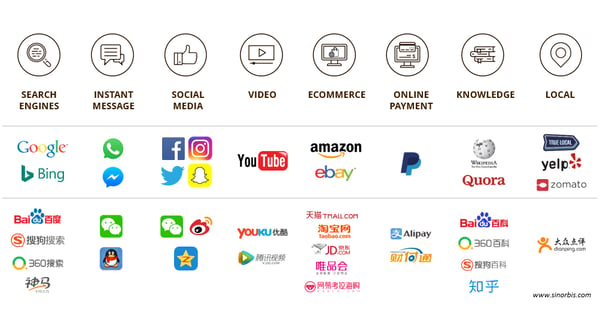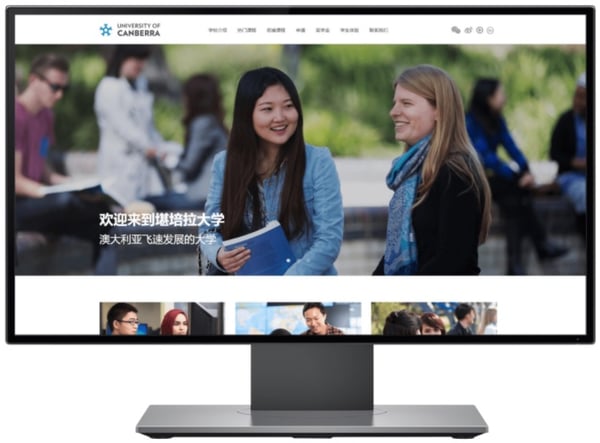China is, in size alone, an exciting prospect for foreign brands looking to grow. But it’s not an easy market to crack – there are technical, legal, and cultural hurdles to executing an effective digital marketing campaign and doing business in China. But the pay-off can be enormous. So, at Sinorbis, we advocate a four-stage acquisition model to transition leads from strangers to loyal customers.
Awareness - Stranger to Lead
The first phase of your customer’s journey is the awareness raising stage. In this stage, prospects are seeking to understand and frame a need or desire. Businesses should focus on multiple channels, such as search engines, information portals, company descriptions and vertical sites for specific industries. China is one of the world’s largest and most advanced digital economies, and the online space is competitive. Understanding your customer, and their digital touchpoints, is key.
There’s no one-size-fits-all approach to which platforms you will utilise in China – it depends on your business and your China strategy, however, they are likely to be entirely different to those you will access in the west. The Great Firewall blocks Google and Meta’s services, meaning YouTube, Facebook, Instagram, and Gmail don’t work. These restrictions on much of the internet’s service infrastructure means foreign websites load too slowly, or not at all, within China.

This is the situation Aarhus University found they faced when they decided it was time to build a digital presence in China – there main website wouldn’t load from within the country. Our Sinorbis team helped build a new, fast-loading China website. The university was then able to monitor what channels were driving results and use the insights to step up recruitment efforts. They partnered with Sinorbis to run a two-week WeChat paid media campaign. The campaign led to a fourfold increase in WeChat account followers and contributed to a 35% increase in Chinese student applications when compared to 2019 – a standout figure when many universities are being challenged by COVID turmoil.
Businesses should not underestimate the power of online reputation. Chinese consumers rely four to five times more on reviews than Western audiences. These reviews are garnered primarily through online forums. Unlike in the West, where the presence of forums have dwindled, China has a bustling presence with a forum or community for almost every industry: Tigtag for Education, Babytree for baby products, Mafengwo for Travel and ITValue for IT professionals, to name a few.
Chinese consumers rely heavily on social proof and online reputation when making decisions. A key metric Chinese consumers use are online rankings. In the retail industry, rankings can come from community sites, eCommerce sites such as Tmall and shopping guide sites. Being well-ranked on your industry’s channel is a powerful tool in building awareness.
The best way to determine the most effective channels for your business is through testing and analysis of data. Once leads are attracted the next phase begins.
Consideration – Lead to Prospect
The consideration stage is when leads are committed to researching all the available options to fulfil their needs. Businesses still engage prospects through generic channels, now with a focus on developing more one-to-one approaches. The goal is to build relationships with these leads. Online communities still play a crucial role at this stage. To help foster these relationships, an official website is ideal in addition to official WeChat marketing and Weibo presences as part of a Chinese social media marketing strategy. These channels will be key touch points for the business, to help discern them from the competition and act as information hubs for leads.
Local businesses wanting to create an online presence in China will find it more complex than simply translating their existing website. For example, the University of Canberra (UC) created a bespoke website that was designed specifically with Chinese audiences in mind. UC was then able further optimise their results thanks to the key insights and advice provided by Sinorbis.

Companies may even find themselves needing to host multiple sites, both locally and in China, due to the varying nature of both Chinese search engines and user experiences. Once prospects are sufficiently engaged, it’s time for conversions.
Decision – Prospect to Customer
The third phase is when the prospect has decided on a product or service that will serve their needs. The objective is to convert them from prospect to customer. For strong customer conversions, travel and retail industries can still leverage specific channels such as online travel agency and eCommerce sites. Official websites, and social media still play a critical role as information hubs. They also serve the ulterior purpose of validating a business’s existence and authenticity. Live chats and personalised pages can also serve to bolster the experience and catalyse the decision-making process.
A powerful tactic to leverage at the decision stage are special offers, or digital events. They can set your business apart from competitors, and be the driving force behind prospect enticement. A prime example of this is the University of Auckland, which used Sinorbis to host a virtual Open Week that was fully integrated into the Chinese digital ecosystem. Following the success of this pilot project, the university has a complete SEO overall planned in order to take advantage of their current momentum.
Turning prospects into customers is not the final aim, however. There lies one final stage, critical to further business development.
Loyalty – Customer to Advocate
The final stage in the process is concerned with nurturing existing customers. The objective is to turn them into advocates. Business advocacy is paramount to business reach and growth especially in a market such as China that relies so heavily on digital proof. Direct channels are the most effective at nurturing such relationships. The focus during this buying stage is now even more so on one-to-one relationships through all online channels such as Weibo and WeChat.
Online reputation management is critical to success when marketing to China. Providing value after customers have made the purchase decisions enables businesses to build their advocacy base and improve their online standing.
From indifference to advocacy
Chinese and Western online eco-systems are completely different. Each local channel has a Chinese counterpart that can differ greatly in both form and function. For Google there is Baidu, Sogou or 360. For WhatsApp there is WeChat. And for Facebook there is WeChat, again. How and when to most effectively harness each is key to successfully marketing in China. Businesses must endeavour to leverage the differences in these online eco-systems rather than be hindered by them.












